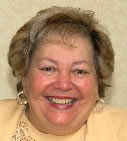  
|
Marjorie Gottlieb Wolfe

Syosset, New York
  
|

*The Yiddish words for clear talk are "klore diburim"
Every hospital "patsyent" (patient) and "bazukher" (visitor) has a story.
My husband, Howard, was recently a"patsyent" at JFK Medical Center, Atlantis, FL, a 450-bed acute care medical/surgical facility. Their lectures and support groups cover a wide variety of topics including, but not limited to, diabetes ("tsukerkrenk"), heart disease ("harts krankayt"), cancer ("rak"), orthopedic-related issues and bariatrics. Thanks to their wonderful care, he's doing fine.
This recent experience reminds me of two stories:
1. A hospital's consulting dietician was giving a lecture ("lektsye") to several community nurses.
"Er hot gezogt" (He said,"The crap that we put into our stomachs and consume should have killed ost of us sitting here years ago. Red meat is horrible. "Gehakt leber" (chopped liver) is bad for you. Fizzy drinks eat your stomach living. Chinese food is loaded with MSG. Vegetables are now 'iffy' because of fertilisers and pesticides... and none of us seem to realize the long-term damage being done by the rotten bacteria in our drinking water ("vaser").
However, there s one food that is incredibly dangerous, and we all have or will (likely), eat it at some time in our lives.
Now, is anyone here able totell me what food it is that causes the most grief and suffering for years after eating it?"
A 65-year-old nurse sitting in the "fornt" (front) row raised her hand, stood up and said, "Wedding cake."
2. The late Sylvia Schildt told this story:
"Ikh gey oys mit a boy."
In mitl shul (high school) I heard a somewht medical version. A Greenhorn comes to stay with relatives in Brownsville and the mama brags, "Mays tokhter geys oys mit a feler." Feler in this case means "heart disease."
So instead of the expected "mazl tov," the Greenhorn says, "Oy, veyzmir!"
She adds: BTW - The American Yiddish of Sholem Aleykhem is perfect. Too bad he never lived long enough to amplify this. Here you can see the language developing right under your nose."
While visiting my husband during his 3-day stay, I noticed several innovations in health care. The hospital uses surgical robots ("Robot Redford'?) and checklists. Their computers offer a program which focuses on patient "nakhis" (satisfaction). They instruct nurses to: ASK. LISTEN. EXPLAIN.
The program says, "Introduce yourself, explain your role, call patient by name, and remember the 6 P's:
PAIN ("VEYTIK"), POTTY, POSITIONING, PHONE, PITCHER, PEACE.
The program continues:
Use appropriate touch. Ask patient to write the 2 or 3 things they want during their stay. It is written on the whiteboard in the patient's room. My husband's nurse, Evelyn (7 p.m. to 7 a.m.) wrote in the "Patient Diary": "Welcometo 2248 - Feel better soon...followed by a happy/ smiling face."
Madeline Drexler ("18 Stethoscopes, 1 Heart Murmur And Many Missed Connections," New York Times, 3/1/11), wrote about medical students who listened to her heart: Flutters, skips, thunks, whooshes, crescendos, desrescendos, tell- tale pitches, and tempos--each conveying a diagnostic meaning.
Ms. Drexler wrote about medical students who didn't bother to ask the patient's name. A Dr. Treadway mentioned in the article, talked about a patient who had 'been in intensive care for three weeks wth a frightening, potentially fatal condition."
"He told us that one of the things that had surprised him most about being a patient was that every single person was he interacted with--be they nurse, resident, senior physician, respiratory tech, physical therapist-it was as though they had a neon sign on their forehead that said either 'I care' or 'I don't care.'"
The artcle ends with these lines: "The students had just learnd the technical term for a heart murmor that a physician can feel: A "thrill." As any patient knows, the touchstone of a good doctor is the ability to feel one's heart."
The final true medical story was told by the late Sam Levenson: Levenson's mothe got sick and sent him to fetch he doctor. It was abou 3 a.m. when he knocd on the door. To his surprise, the doctor appeared fully clothed and was heading to "bet" (bed) when Sammy announced, "My mudder is sick."
He knew my mudder and if she sent for the doctor she had to be good and sick.
The doctor goes to the house, bends over his mother, but found that he had forgotten his little black ("shvarts") bag. There was no stethoscope because it was in the little "shvarts" bag.
Instead of going back for it, he resorted to the "alt" (old) fashioned method of listening to the patient's heart. He rested his head and ears on Mama's ample bosom ("buzem"), and toldher to count aloud. She began, one, two, three, four...."eyns, tsvey, dray, fir"...
When the doctor opened his eyes, Mama
was up to four million and ninety one. The
sun ("zun") was up: the doctor was asleep
("shlof"). He felt better ("besser")... and
she
felt better. All the doctor said before he
left was "No charge!" "oom-zeest!" (free).
__________________
Marjorie reminds her readers that visiting
the sick ("mevaker khohyle") is always a
mitzvah/mitsve.
| A | B | C | D | E | F | G | H | I | J | K | L | M |
| N | O | P | Q | R | S | T | U | V | W | Y | Z |


| Yiddish
Stuff Jewish Humor Schmooze News More Majorie Wolfe |
Principle Jewish Stories All Things Jewish Jewish Communities of the World |